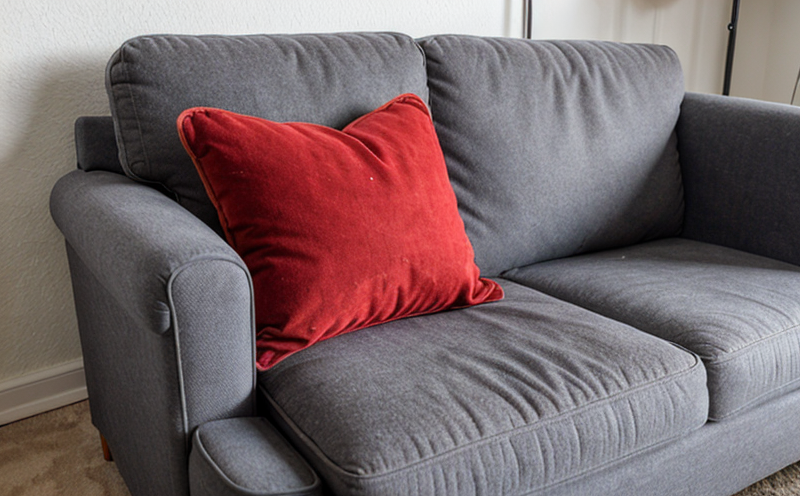ISO 13934 Tensile Strength Testing of Upholstery Fabrics
The ISO 13934 standard is widely recognized in the upholstery and furniture testing industry as a critical tool for ensuring product durability. This test measures the tensile strength of upholstery fabrics, which is essential to guarantee that cushions and seating products can withstand repeated stress without tearing or failing. Upholstery fabric manufacturers, suppliers, and retailers rely on this test to ensure quality control and compliance with international standards.
During ISO 13934 testing, a sample is cut from the upholstery fabric according to specified dimensions. The specimen is then clamped into a tensile testing machine designed specifically for textile samples. The machine applies increasing force until the fabric fails. The maximum load at which this failure occurs is recorded as the tensile strength of the material.
The test setup and sample preparation are critical aspects that must be adhered to precisely to ensure accurate results. Samples should be prepared in a controlled environment, free from external factors like humidity or temperature fluctuations that could affect the outcome. The sample cut should replicate real-world conditions as closely as possible to provide meaningful data.
Understanding tensile strength is crucial for quality assurance and product development. It helps manufacturers identify potential weaknesses in their materials early on. For instance, if a fabric has an unexpectedly low tensile strength, it may not be suitable for high-stress areas of furniture like armrests or seating surfaces where users will frequently shift weight.
The ISO 13934 standard provides detailed guidelines to ensure consistency and accuracy in testing. Compliance with these standards ensures that the results are reliable and can be compared across different laboratories. This is particularly important for international trade, as it allows manufacturers from various countries to adhere to a common benchmark.
By using ISO 13934 tensile strength testing, furniture manufacturers can enhance their product quality by identifying which fabrics perform best under stress conditions. This information can be used to make informed decisions about material selection and design improvements. It also helps in maintaining brand reputation by ensuring that products meet or exceed customer expectations regarding durability.
Furthermore, this test supports sustainable practices within the industry. By selecting materials with higher tensile strengths, manufacturers contribute towards reducing waste from premature product failure. Such efforts align closely with global sustainability goals and can lead to cost savings through reduced replacement rates and improved resource utilization.
In summary, ISO 13934 testing plays a vital role in ensuring the durability of upholstery fabrics used in furniture manufacturing. Its application ensures that products meet stringent quality standards, supports sustainable practices, and enhances overall customer satisfaction. The precision required for successful implementation underscores its importance as an industry standard.
Benefits
The adoption of ISO 13934 testing offers numerous advantages to various stakeholders within the upholstery and furniture manufacturing sector:
- Improved Product Quality: Ensures that all fabrics used in cushioning meet the required tensile strength specifications, leading to higher quality products.
- Promotes Compliance: Helps manufacturers adhere strictly to international standards, facilitating smoother trade processes and reducing risks associated with non-compliance penalties.
- Enhanced Reputation: By consistently delivering durable furniture components, businesses can enhance their market position and build trust among consumers.
- Sustainable Practices: Encourages the use of more robust materials that last longer, thereby minimizing waste generation and promoting eco-friendly manufacturing processes.
- Economic Efficiency: Reduces unnecessary replacements due to early failures, translating into significant cost savings for both manufacturers and end-users.
- Innovation: Provides insights into fabric performance under stress conditions, prompting innovations in material science and design.
The comprehensive benefits of ISO 13934 testing extend beyond mere compliance; they contribute significantly to the success and longevity of enterprises operating within this competitive market space.
Industry Applications
The application scope of ISO 13934 Tensile Strength Testing extends across multiple segments of the furniture manufacturing industry, including:
- Home Furniture: Ensures that seating and sofa cushions remain intact under normal use conditions.
- Commercial Seating: Guarantees durability in office chairs, conference room seating, and other commercial applications where frequent user interaction occurs.
- Hospital Furnishings: Provides assurance of safety and reliability for hospital beds and medical equipment upholstery.
- Sporting Goods: Ensures that padding used in athletic gear withstands rigorous physical activities without compromising on performance or integrity.
- Luxury Automotive Seats: Maintains the premium standards expected by consumers who demand exceptional comfort and longevity from their vehicle interiors.
These diverse applications highlight the versatility of ISO 13934 testing across different sectors, emphasizing its relevance in maintaining high-quality standards throughout the entire furniture supply chain.
International Acceptance and Recognition
The ISO 13934 standard enjoys widespread acceptance globally due to its rigorous approach towards measuring tensile strength. Developed through collaborative efforts involving experts from various countries, this standard ensures that testing procedures are consistent worldwide. This uniformity fosters trust among international buyers and sellers, simplifying cross-border transactions.
Many reputable organizations around the globe have adopted ISO 13934 as a benchmark for evaluating upholstery fabric quality. These include prominent furniture manufacturers, retailers, and regulatory bodies responsible for setting industry standards. The standard's broad acceptance enhances its credibility and reliability, making it an indispensable tool for maintaining international trade relations.
Compliance with ISO 13934 not only demonstrates adherence to high-quality benchmarks but also signals commitment to excellence in product development. For businesses aiming to expand their markets internationally, compliance provides a competitive edge by demonstrating alignment with global standards.
The recognition of ISO 13934 extends beyond national borders; it is embraced by international bodies such as the European Union and United States authorities. This universal endorsement underscores its significance in fostering transparency and consistency within the global furniture manufacturing sector.





